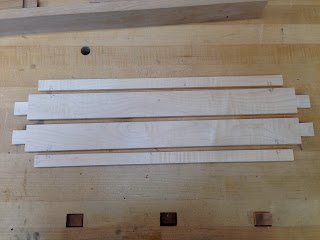One of the things that really appealed to me of this Krenov cabinet. It mostly but not completely blocks the contents of the cabinet. For what I wanted in this cabinet this was perfect. I decided to use this panel as an opportunity to have a nice complimentary wood. I was at Rockler and I found a really nice piece of figured maple that was either 3/4 or 1/2" thick. Wasn't cheap from a board foot perspective but I didn't need that much.
The biggest problem with the piece of maple was that it had a significant bow in it. With lots of patience and careful work, finally got rid of the bow; however, my stock ended up being about 1/4" think. I was hoping to have 3/8" thick. Oh well, really won't matter from a functional perspective. Put 1/4" mortises on the rails. I decided to attach the two shorter panel pieces to the large one by wedges of wood. There is probably some sort of fancy name for this connection but I don't know what it is. Came out good.
After the glue up of this panel, I prefinished it with blond shellac that I made up fresh (ca. 1-1/2 lb cut) that I dissolved in 97%ish isopropanol. Why isopropanol you ask? Just before Covid became a big issue in the USA, I stocked up on a bunch of bottles of it for disinfecting. I didn't use that much for disinfecting. Since I have it around, I have repurposed it. As best I can tell, it works just about as well as 190 proof ethanol; maybe it took the shellac a bit longer to dissolve in the isopropanol.. I was curious so that is why I did this experiment. Generally speaking, I'd prefer to use 190 drinking grade Everclear for my shellac. I will likely use the remaining isopropanol to clean my shellac brushes since it costs a lot less than any form of ethanol I can purchase.
The door glue up was uneventful. Project is really close to completion (one or two more posts).



























































